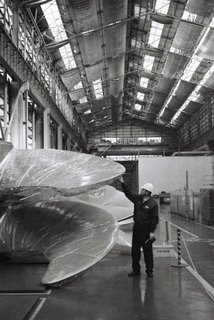Their tests are tempests and the sea that drowns.
They are my country’s line, her great art done
By strong brains laboring on the thought unwon.
- John Masefield, “Ships”
This past weekend saw the annual celebration known as Battle of the Atlantic Sunday, a day reserved to commemorate those men and women who fought, and were lost at sea, during the Second World War. It is an event heavily overshadowed by November’s Remembrance Day, but an important one nonetheless. Though we often think of uniform-clad sailors, soldiers and airmen as being on the knife’s edge of war, the Battle of the Atlantic inflicted a great toll on civilians: merchant mariners struggling to feed the war effort.
 HMCS Sackville, Canada's naval memorial
HMCS Sackville, Canada's naval memorialThe price paid by merchant mariners of all nations in the last two World Wars was atrocious. There really is no other way to describe what these mostly unarmed men endured feeding the war effort. To be a merchant mariner in either war meant you were far more likely to die than if you were serving in uniform on a naval vessel. To give you an idea of the dangers, consider that 534 Allied merchant ships were sunk in the Second World War just from enemy mines. That works out to about one in ten ships lost, because over 5000 cargo vessels were sunk in that war. In the Atlantic Ocean alone, 50000 civilian mariners died between 1939 and 1945; they died of horrible burns caused by explosions, gunned to death as they clung to flotsam or drowned alone in the frigid waters of the North Atlantic.
However, for their heroic service in helping to defeat the enemy many merchant mariners found that once the war had ended they were treated as second-class veterans, denied pensions and other benefits accorded to their naval brethren. In Canada, it took until 1998 before these men received official government recognition and compensation. And little has changed. When it comes to war, the role of mariners remains as invaluable to governments today as it has throughout history, but their contributions continue to be overshadowed by others. Rarely has a conflict been waged without the support of sailors manning cargo vessels, whether it be the Trojan Wars, Napoleon’s conquests, the Korean Conflict or the struggle to remove Saddam Hussein.
I’ve had the pleasure – if that’s the proper word – to cross the North Atlantic during some of it’s most vile of moods, firsthand encounters with a tempestuous entity that always left me shaken. But that was on some of the most modern of vessels to be found, in peacetime. I can barely fathom the ordeal it must have been to cross that ocean in primitive tin cans, while also facing the prospects of an enemy intent on killing you.
In a Greenwich dry dock beside the Thames River lies the majestic ship Cutty Sark, a memorial to the age of sail and the toils of ordinary seafarers. And at one end of the dry dock lies a small tablet bearing the words of the English poet laureate John Mansfield. They are the last two lines from his epic poem “Ships”, an apt honorific to anyone who endured the Battle of the Atlantic in whatever vessel flying whatever flag.
Chiseled into the wall, it simply reads: “They mark our passage as a race of men – Earth will not see such ships as those again.”








